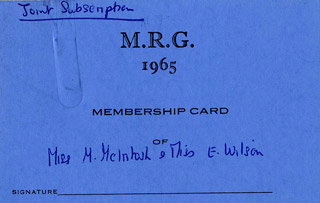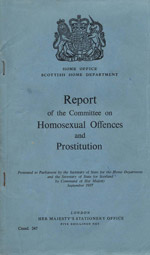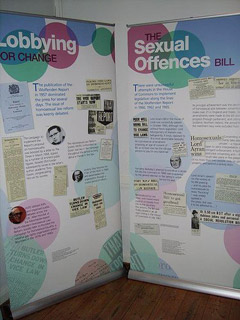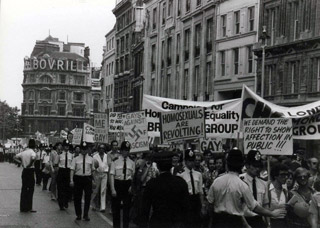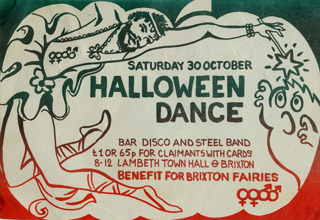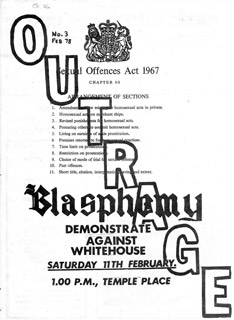1967 and all that
Putting the campaign for law reform in its historical context

In 1967 male homosexuality was finally decriminalised, a milestone in gay history and a big step towards equality before the law for homosexuals. But how did this come to pass?
This exhibition, using archives from the Hall-Carpenter Archives of lesbian and gay activism and press cuttings from the collection of the Lesbian and Gay Newsmedia Archive, puts the campaign for law reform in its historical context, charts the progress of reform proposals through parliament and illustrates the impact the change in law had on the gay rights movement.
Overview
Timeline
1954 The government appoints Sir John Wolfenden to head a Committee examining the law on male homosexuality and prostitution.
1957 The Committee publishes its report. Its recommendations: homosexual activity between consenting adults over the age of twenty-one, in private, be no longer a criminal offence.
1958 The Homosexual Law Reform Society is founded to lobby the Government to implement the Wolfenden recommendations.
1958 House of Commons debates the Wolfenden Report for the first time. The Home Secretary, Rab Butler, rejects calls to implement the proposal on homosexuality.
1960 Labour MP Kenneth Robinson proposes a motion calling on the Government to enact in law the Wolfenden recommendations. This is defeated on a vote.
1960 Labour MP Leo Abse attempts to introduce legislation to mitigate the effects of the existing laws on homosexuality. This measure is debated and defeated in the Commons.
1965 Lord Arran introduces his Sexual Offences Bill into the House of Lords. Despite opponents such as Lord Montgomery, it is passed in October.
1965 Leo Abse's attempt to introduce the same Bill into the Commons is unsuccessful.
1966 Conservative MP Humphry Berkeley's Sexual Offences Bill successfully passes its First and Second Reading in the Commons. However, a general election is called, and the Bill's process is scuppered. Berkeley loses his seat at the subsequent general election.
1966 Leo Abse reintroduces his Sexual Offences Bill into the Commons.
1967 The Sexual Offences Bill passes its Third Reading in the Commons on the 4th of July. It receives the royal assent on the 21st of July.
Gay life in the 1950s and 1960s
Until the passing of the Sexual Offences Bill in 1967, male homosexual activity was illegal. Gay men were frequently imprisoned for consensual sex with another man. Lesbianism was not illegal, but was similarly subject to public disapproval, or ignored.
Despite the dangers and difficulties involved, gay men and women were able to find places to meet. The Minorities Research Group (MRG) was formed in 1964, and provided isolated lesbians with resources and information about female homosexuality and the opportunity to meet other women.
Men had roundabout ways of finding places to go. Allan Horsfall of the North-Western Homosexual Law Reform Committee, remembers:
"The story goes ... of someone who went to work in a strange town and didn't know where the gay community was. So he went into a pub and said, "I've only been here two days - the first pub I went in was full of nancy boys. I can't quite remember the name of it," and two or three people turned round and said "Oh you mean the Rose and Crown". So he drank up and went down the Rose and Crown, and that was the way people found their way around in those days." LSE/HCA/Jeffrey-Poulter/6
Police activity against gay men was rife throughout the 1950s. Many homosexuals were blackmailed, although only a fraction came to the attention of the police. The film Victim of 1961 brought these issues to a mainstream audience. It starred Dirk Bogarde as a repressed, married homosexual taking on the blackmailers who drove his partner to suicide.
The belief that homosexuality constituted an illness and could be cured was a staple of the popular press during the period.
Lobbying for change
The publication of the Wolfenden Report in 1957 dominated the press for several days. The issue of homosexual law reform was keenly debated.
The campaign to implement the Report's proposal on homosexuality was boosted by a letter to the Times in March 1958, signed by a number of eminent public figures. Novelist E.M. Forster subsequently wrote to the letter's author, academic Tony Dyson, congratulating him on his success.
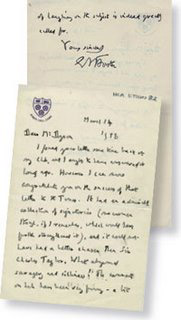
"March 14 1958
Dear Mr Dyson
I found your letter some time back at my Club, and I ought to have answered it long ago. However I can now congratulate you on the success of that letter to The Times. It had an admirable collection of signatories (no women though, if I remember, which would have further strengthened it), and it could not have had a better chaser than Sir Charles Taylor. What abysmal savagery and silliness! The comments on him have been very funny - a bit of laughing on the subject is indeed greatly called for.
Yours sincerely
EM Forster"
LSE/HCA/DYSON/1 © the Provost and Fellows of King's College Cambridge. Reproduced by kind permission of the Society of Authors as agent for the Provost and Scholars of King's College Cambridge.
The Homosexual Law Reform Society (HLRS) co-founded by Dyson was key in the campaign throughout the period to bring about a change in the law.
Antony Grey became the Chair of the HLRS in 1963 and spearheaded the organisation through a crucial period of reform.
HLRS lobbied MPs and organised public debates across the UK. Allan Horsfall of the Manchester-based North-Western Homosexual Law Reform Society later co-founded the Campaign for Homosexual Equality, a national gay rights organisation which flourished in the 1970s and 1980s.
The Sexual Offences Bill
There were unsuccessful attempts in the House of Commons to implement legislation along the lines of the Wolfenden Report in 1960, 1962 and 1965.
Lord Arran's Bill in the House of Lords was successfully passed in October 1965, although not without fierce opposition. Lord Montgomery of Alamein was belligerently, if wryly, opposed to "this most abominable bestiality". He submitted an amendment proposing an age of consent of 80, as "at least one has the old-age pension to pay for any blackmail."
Humphry Berkeley's attempt to introduce a similar Bill into the Commons in 1966 was scuppered by the general election in the Spring in which he lost his seat.
Reintroduced by Leo Abse, with Government support principally from the Home Secretary Roy Jenkins, the Bill was finally passed in an all-night sitting in the House of Commons in July 1967.
Its principal achievement was the decriminalisation of homosexual acts between consenting adult males over 21, in England and Wales. Various amendments were made to the Bill during its progress through parliament, and ultimately Scotland, Northern Ireland, the armed forces and the merchant navy were excluded from its remit.
Consenting acts could only take place "in private" - a stipulation open to strict interpretation and stringent enforcement. It further restricted consenting acts - they could take place in the presence of no more than two people, only on private property and behind a locked door.
Lord Arran's speech on the victory of his Bill passing - and his plea for homosexuals to resist "flaunting" - was widely quoted in the press, but was it to be adhered to ... ?
The aftermath of the Act
Lord Arran's speech rankled with the gay community. Though Arran himself believed his Bill would go on to save the lives of a million depressed and persecuted gay men, it was generally perceived that the Act had not gone far enough in improving conditions for gay people.
In the early 1970s gay rights organisations were springing up locally and nationally, each campaigning for a lowering of the age of consent of 21 that had been recently endorsed by the Sexual Offences Act. The law's condition that consenting sex had to take place "in private" ensured that prosecutions for sex in public places continued at a high rate, boosted by tactics of "pretty police" entrapment.
The Gay Liberation Front was formed in 1970. It organised protest action and awareness-raising campaigns against the various forms of discrimination continuing to affect gay men and women. The conservative Christian organisation, the Festival of Light, was the target of several protests. Street theatre, marches and demonstrations took place in London and other regions, making gay men and lesbians more visible than ever before. The photograph below shows the first Gay Pride march in London in 1972.
Male homosexual activity was finally decriminalised in Scotland in 1980, and in Northern Ireland in 1982. However, the age of consent for gay men did not achieve parity with that of heterosexuals until 2001, 34 years after the legislation was originally passed.
Archives and sources for LGBT history
The Lesbian and Gay Newsmedia Archive (LAGNA) is based at Middlesex University and boasts a collection of 200,000 press cuttings documenting gay life from the 1930s to the present.
So whether you are interested in the recommendations of the Wolfenden Committee in the 1950s, who wore what and why at the Gateways club in the 1960s, the Gay Liberation Front and The Festival of Light in the 1970s, Clause 28 and the ramblings of James Anderton in the 1980s, pink pounds and gay villages in the 1990s or Todd Grimshaw's coming out on Coronation Street in the 2000s, if the press covered it, LAGNA will have the story.
The Hall-Carpenter Archives (HCA) of lesbian and gay activism date from the 1950s and are held at the Library of the London School of Economics.
The archives of influential organisations from the gay rights movement are represented, including the Campaign for Homosexual Equality, Albany Trust, and the Lesbian and Gay Christian Movement, as well as the personal papers of the activists Antony Grey, Peter Tatchell, Mary McIntosh and Simon Watney.
There is also an extensive collection of gay magazines, newspapers and ephemera from the second half of the 20th century, representing LGBT events and organisations from across the UK and internationally.
Press releases and coverage
- October 2007: Out In The City (760 KB) article by Robert Thompson, [archived on this website] with thanks to the publisher & editor.
- August 2007: Time Out (London) coverage of the Exhibition.
- 21 to 26 July 2007: 40 Years On - five programmes on Channel 4.
- 29 June 2007: Gay and Lesbian Humanist Association Events webpage.
- 20 June 2007: Q Alliance blog, Milton Keynes and Buckinghamshire.
- 3 March 2007: The Times, Top Five Museums - No.1 is our exhibition at the Church Farmhouse Museum.
- 25 February 2007: Barnet Council Press Release for the exhibition.
- 25 February 2007: Pink News, London.
- Feb - Mar 2007: webpage by the Archives Awareness Campaign, The National Archives, London.
- 30 January 2007: London Borough of Barnet website coverage of our launch exhibition at Church Farmhouse Museum, Hendon which ran from 2nd February to 18th March 2007.
Organised by Barnet LGBT* Network and LAGNA, for LGBT History Month. - Weblinks to Talks by Robert Thompson on the LGBT History Month 2007 website (and many other local authority websites).
- See also the blog of our Exhibition.
* lesbian, gay, bisexual, transgendered
